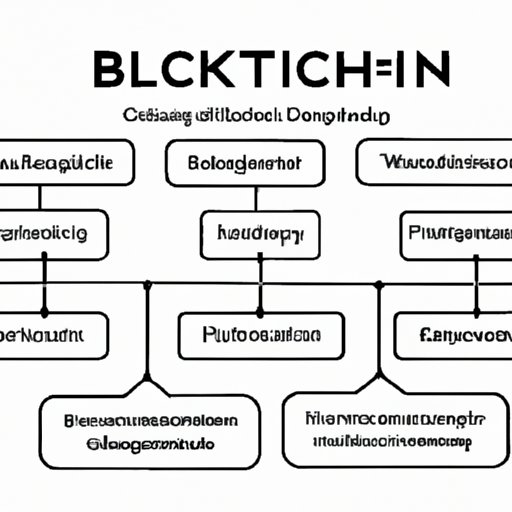Introduction
Blockchain technology is a revolutionary new way of managing data and conducting transactions. It has been gaining traction in recent years due to its ability to securely store and transfer information without the need for a centralized authority. In this article, we’ll explore what a blockchain is, how it works, and the benefits it offers.
Explaining Blockchain Technology and How it Works
A blockchain is a distributed ledger technology (DLT) that records digital transactions in a secure and immutable manner. It is composed of blocks, which are linked together in a chain-like structure. Each block contains a cryptographic hash of the previous block, a timestamp, and transaction data. This makes it difficult to tamper with or alter existing blocks.
The way a blockchain works is by using consensus algorithms to validate transactions and add them to the chain. When a transaction is initiated, it is broadcasted to all nodes in the network. The nodes then verify the transaction and reach a consensus on whether it is valid or not. If approved, the transaction is added to a new block, which is then linked to the existing blockchain.
Steps Involved in a Typical Blockchain Transaction
When a user wants to make a transaction on a blockchain, there are several steps involved. First, the user must set up the transaction, which includes providing the recipient’s address and the amount to be sent. The transaction is then broadcasted to the network, where it is validated by the nodes. Once validated, the transaction is recorded on a new block, which is then added to the chain.
The transaction is then permanently stored on the blockchain, and it can be seen by all users on the network. This ensures that the transaction is secure and cannot be altered or tampered with. The entire process takes only a few minutes and is much faster than traditional banking methods.
Benefits of Using Blockchain Technology
One of the main advantages of using blockchain technology is increased transparency. All transactions are visible on the blockchain and can be verified by anyone. This makes it easier to track transactions and ensure that the data is accurate and up-to-date.
In addition, blockchain technology offers improved security. Transactions are secured using encryption and are immutable, meaning they cannot be changed once they are added to the chain. This makes it virtually impossible for hackers to access or alter the data. Finally, blockchain technology can reduce costs associated with traditional banking methods, such as fees and paperwork.

Types of Blockchains and Their Use Cases
There are several different types of blockchains, each with their own use cases. Public blockchains are open to anyone and allow users to read, write, and participate in the network. Private blockchains are restricted to certain users and are typically used for enterprise applications. Consortium blockchains are controlled by a group of organizations, while hybrid blockchains combine elements of public and private blockchains.
These various types of blockchains can be used for a variety of applications. For example, public blockchains are often used for cryptocurrency transactions, while private blockchains are used for supply chain management, banking, and payments. Consortium blockchains are ideal for healthcare applications, while hybrid blockchains are used for a combination of purposes.

Security Features of Blockchain Technology
Blockchain technology is highly secure due to its use of encryption and immutability. Encryption ensures that data is kept secure and can only be accessed by authorized users. Immutability ensures that once a transaction is added to the blockchain, it cannot be altered or tampered with.
In addition, blockchain technology is decentralized, meaning that it is not controlled by any single entity. This makes it more resilient to attacks, as there is no central point of failure. These features make blockchain technology extremely secure and reliable.
Real-World Examples of Blockchain Implementation
Blockchain technology is being used in various industries to improve efficiency and reduce costs. In the supply chain management industry, blockchain is being used to track the movement of goods and ensure that they are delivered on time. In the banking and payments sector, blockchain is being used to facilitate faster and more secure transactions.
In the healthcare industry, blockchain is being used to securely store patient data and ensure that it is only accessible by authorized personnel. Finally, blockchain is being used in the energy sector to enable the buying and selling of renewable energy.

Challenges and Potential of Blockchain Technology
While blockchain technology offers many benefits, there are still some challenges that need to be addressed. One of the main issues is scalability, as the current blockchain networks are limited in terms of the number of transactions they can process. Interoperability is another challenge, as different blockchains are not compatible with one another.
Finally, the regulatory environment is still uncertain, as governments around the world have yet to provide clear guidelines on how blockchain should be regulated. Despite these challenges, the potential of blockchain technology is immense and it could revolutionize many industries in the near future.
Conclusion
In conclusion, blockchain technology is a revolutionary new way of managing data and conducting transactions. It offers increased transparency, improved security, and reduced costs compared to traditional methods. There are several different types of blockchains, each with their own use cases, and they are being implemented in various industries. However, there are still some challenges that need to be addressed before blockchain technology can reach its full potential.
(Note: Is this article not meeting your expectations? Do you have knowledge or insights to share? Unlock new opportunities and expand your reach by joining our authors team. Click Registration to join us and share your expertise with our readers.)
